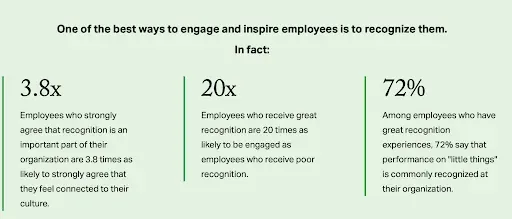How to Build a Year-Round Employee Recognition Strategy That Works in 2025
Discover how to implement a successful year-round employee recognition strategy that enhances morale, boosts engagement, and fosters a culture of appreciation. Learn actionable tips to keep your team motivated and valued all year long.
في هذه الصفحة
Despite the best intentions, many organizations still fall short when it comes to appreciating their employees consistently. Recognition is often reserved for annual reviews or milestone moments—leaving everyday efforts unnoticed. But here’s the truth: a culture of consistent appreciation can transform the way your people feel, work, and grow.
That’s where a year-round employee recognition strategy comes in.
When recognition becomes part of your company’s DNA, it boosts morale, strengthens engagement, and drives performance across the board. The key is building a strategy that’s intentional, inclusive, and woven into the daily rhythm of work—not just saved for special occasions.
In this blog, we’ll show you how to create a recognition program that’s impactful every day of the year. You’ll explore powerful tips, proven frameworks, and real-world employee recognition strategy examples to help you celebrate your people meaningfully—and often.
Let’s dive in and build a culture where appreciation never takes a back seat.
What is an employee recognition strategy?
An employee recognition strategy usually entails recognizing and appreciating the actions and achievements of employees in a given company. It often comes with awards and rewards as tokens of appreciation handed to the achievers or performers.
In a recent report about Empowering Workplace Culture through Recognition, Gallup cites that recognizing employees is one of the best ways to inspire and engage them.
The proof is in the numbers:
- Those believing in employee recognition are more likely to agree they have connections with the company culture (about 3.8x).
- Those receiving great appreciation are more likely to engage than those with poor recognition (about 20x).
- Over 70% of employees with great recognition experiences believe that performance recognition on "little things" is common in their organization.

7 Effective tips for creating a year-round employee recognition strategic program
Given the benefits discussed above, it’s crucial to set an employee recognition program in place. However, this program should be a year-long initiative. In fact, your organization should foster a culture of appreciation that lasts a lifetime.
That said, here’s how to create an effective year round employee recognition strategy:
1. Plan an employee recognition program all year round
For an employee recognition program to be successful, it shouldn’t be a one-time deal. Implement it throughout the year with some appreciation activities and rewards events held regularly. Promoting a culture of recognition should be a way of life in the workplace.
First off, create a team under your human resource (HR) department responsible for planning and executing the employee recognition program. To get started, follow the steps below:
- Define goals. They should be SMART—specific, measurable, achievable, realistic, and time-bound. Ask what you hope to achieve from this program: Is it to increase job satisfaction and employee retention? Is it to improve productivity and profitability? Or is it to promote an inclusive, harmonious, and engaged team?
- Set metrics. The key performance indicators (KPIs) should revolve around efficiency/productivity, quality/compliance, and customer satisfaction (CSAT). They help monitor and measure employee performance to identify and reward performers and achievers.
- Monitor performance. Your quality assurance (QA) team tracks and measures employee performance. While they determine who deserves to be rewarded, they should also motivate the rest and appreciate those who strive hard and exert effort.
- Give recognition. The management team should hold the scheduled events on the calendar to recognize performers and extend rewards. Keep in mind, however, that providing appreciation, even in simple ways, should be a day-to-day initiative.
Empuls makes year-round recognition not only possible—but effortless. With its automated reward cycles, built-in scheduling, and customizable workflows, Empuls helps HR teams set up monthly, quarterly, and annual recognition programs without the manual load.

You can define goals, allocate budgets, and launch campaigns that run like clockwork. Whether it's appreciating top performers every month or celebrating milestones as they happen, Empuls ensures that recognition becomes a consistent and integral part of your company’s culture.
Max Wesman, Founder & COO of GoodHire, recommends proper planning and strategic execution for an employee recognition program.
Wesman said, “You and your team should sit down and brainstorm to come up with a year-round program…something that truly works and adds value to your company and employees. Remember, fostering a culture of appreciation is no easy feat, but it can make a world of difference in the workplace!”
2. Introduce the recognition program to your team
After setting up a blueprint for your employee recognition program, it’s time to introduce it to your team. You can assign a team meeting online or send an email newsletter for everyone with motivating call-to-action. The key here is to be clear on what the program entails and set proper expectations. You want to ensure that the entire team understands its purpose and that every stakeholder must participate.
Here’s how to officially launch the employee recognition program:
- Send emails to all employees for the guidelines. This email should include all the necessary details, from the program goals to the scheduled activities. Encourage everyone to partake and contribute to the initiative’s success.
- Hold a brief orientation about the program. If possible, gather all employees and have an HR representative explain what the program is all about. If not, let your team leads orient their individual teams.
- Open lines of communication for participation. Getting everyone involved in this initiative is vital for overall success. Encourage constant interactions by giving updates, asking for suggestions, and letting teams communicate with each other.
Getting your team aligned on a new recognition initiative is easy with Empuls. The platform allows you to introduce your program through personalized in-app announcements, company-wide broadcasts, or integrations with communication tools like MS Teams, Slack, and email.

You can share program guidelines, reward policies, and participation instructions right within the tools your employees already use. This clarity and accessibility empower every employee to engage with the program from day one—ensuring strong adoption and buy-in across the organization.
Robert Kaskel, Chief People Officer at Checkr, suggests proper orientation for the employee recognition initiative.
Kaskel said, “For the most part, companies and organizations have rewards and recognition programs in place. However, many employees aren’t aware that they exist and that they should strive hard to give their best. That said, properly orient your team on this program to ensure they participate and that you achieve your objectives.”
3. Hold recognition events on a regular basis
It’s best to regularly have rewards and recognition events for the program’s consistent implementation. Not only do they let employees know this program exists, but regular events set employee expectations and provide them with real excitement. These events must be something they look forward to.
Wondering how frequently you should hold these events? It actually depends:
- Monthly: It’s a good idea to recognize the top performers for the month. You can gather all employees in a town hall meeting for about an hour or so every month. And from there, you can give awards to the top achievers!
- Quarterly: The quarter event should go beyond recognizing top performers. If the budget allows, hold a team building for everyone. It’s a great way to show how much you appreciate and value each and every employee!
- Yearly: It’s easy to see companies hold an annual event that converges all team members in one place. And while at it, they give awards to the top performers for the year, hold raffle draws, and let employees have fun for a night or so.
- Daily: An employee recognition program isn’t confined to the regular events mentioned above. It’s a day-to-day initiative that both leaders and employees should constantly practice. A simple appreciation note sent to the employee’s email like “You did a great job today” will do!
While monthly town halls and quarterly events are great for visibility, Empuls ensures recognition doesn’t stop there. With automated greetings, birthday shout-outs, work anniversary messages, and achievement-based celebrations, Empuls brings recognition into the flow of work.

Whether your teams are working in-office, hybrid, or fully remote, the platform keeps the appreciation going with personalized and timely acknowledgments. This creates a culture where employees feel seen, valued, and celebrated—every single day.
Catherine Schwartz, Finance Editor at Crediful, underscores the importance of employee recognition programs.
Schwartz said, “They create positive repercussions to your company culture. Recognizing and rewarding employees lets them feel they are truly valued and appreciated. However, hold regular events and activities related to the program to get employees involved and engaged.”
4. Provide recognition in various forms
We often think of an employee recognition program as holding a rewards event and awarding the achievers. However, it goes far beyond that. You can appreciate, recognize, and reward your employees in various ways.
Below are the different forms of recognition provided in the workplace:
- Formal recognition is officially recognizing and rewarding employees in public. The monthly event is a perfect example, where you give awards to the top achievers for the month.
- Informal recognition doesn’t have to be official and formal. Think of supervisors giving their subordinates a thumbs up or a pat on the back for doing a great job!
- Monetary recognition requires money where employees are given monetary compensation for meeting and exceeding targets. Perks and incentives fall under this category.
- Social recognition involves peers appreciating each other’s hard work done publicly or privately. This recognition is meaningful since it comes from someone employees work with daily.
- Day-to-day recognition is informal recognition that occurs daily. For example, a supervisor might let others on the floor know that an employee has just made successful sales!
- Celebratory events are formally organized by the organization and attended by employees. A Christmas party held annually for the company is a perfect example of this!
Recognition comes in many forms—and Empuls supports them all. Whether you want to run a formal rewards program, foster peer-to-peer appreciation, or enable managers to send spot awards, Empuls has the tools to make it happen.

Employees can receive shout-outs, badges, points, and even redeemable rewards through a global catalog with 1M+ options. Plus, the platform enables social recognition through likes, comments, and reactions, making every win visible and celebrated across the organization. With Empuls, recognition becomes meaningful, multi-dimensional, and memorable.
Volodymyr Shchegel, VP of Engineering at Clario, suggests holding different recognition events.
Shchegel added, “Don’t just have regular rewards and recognition events held monthly, quarterly, or yearly. It’s best to give employees an element of surprise…something that they should look forward to. Bet you have seen the value of a team-building activity in your organization.”
5. Monitor and measure employee performance
Performance monitoring and measuring are a crucial part of your employee recognition program. Ensure constant tracking and fair evaluation to avoid disputes and recognize achievers. But more than anything else, the goal is to improve employee performance by identifying and addressing areas for improvement.
As such, the KPIs usually focus on the following areas:
- Efficiency/productivity: Track how fast employees accomplish their days or how many outputs they produce daily. For example, you measure the average handling time (AHT) for your call center. Or you count the number of outputs produced in a day for your back-office work.
- Quality/compliance: Monitor if employees strictly follow quality standards and comply with business policies. Do they follow the standard operating procedures (SOPs)? Are they not committing any compliance deviation? Standards guarantee the employees’ work quality and service delivery.
- Customer satisfaction (CSAT): Measure if customers are fully satisfied with the services they receive from your employees. Often, your company issues surveys to get customer feedback and obtain employee ratings. CSAT should be a key part of your scorecard.

You can map recognition data to KPIs like productivity, quality, and customer satisfaction—giving you a real-time view of who’s excelling and where support is needed. With Empuls, recognition isn’t just feel-good—it becomes a strategic lever to drive continuous performance improvement.
6. Get everyone involved in for inclusive recognition
The employee recognition program doesn’t only include the HR personnel. Neither does it apply to the workers exclusively. This program involves all the stakeholders in a company, from the top management to the HR down to rank-and-file employees.
That said, here’s what the stakeholders involved are responsible for:
- HR team: The HR personnel usually initiate, execute, and reinforce the employee recognition program. They create an employee engagement team to set and schedule the program’s events and activities.
- Upper management: The top management leaders usually coordinate with the HR and implement the program within their departments or jurisdictions. While the QA team monitors and measures employee performance, the team leads manage their immediate members or subordinates.
- Rank-and-file employees: The workers aren’t just the recipients of the rewards and recognitions. They are responsible for delivering their best, improving performance, and contributing to the organization. They can also offer peer-to-peer appreciation to their colleagues and give management appreciation to business leaders.
Managers also receive intelligent insights to spot recognition gaps and ensure no effort goes unnoticed. By involving everyone, Empuls fosters a culture where recognition is not limited to hierarchy—it’s shared, frequent, and inclusive.
7. Promote a culture of appreciation within your organization
An employee recognition program shouldn’t only be a band-aid solution for employee engagement and business success. It should be a part of your company culture where employees are constantly recognized, appreciated, and valued at work.
What better way to take your program to the next level than to foster a culture of appreciation in your organization? Here’s how:
- Open lines of communication. Encourage constant interactions not only among team members but also among different departments. You can do this by breaking down silos and putting up cross-functional collaborations.
- Appreciate even small wins. Employee recognition doesn’t have to be grand and great. Even small gestures of appreciation can go a long way in boosting employee morale. Genuine “thank you” and “good job” are phrases that create magic in the workplace!
- Connect employees to higher causes. It’s essential to let employees know that this recognition program has a bigger purpose. Allow them to understand that this can help create job satisfaction, advance career, improve performance, and guarantee overall business success.
- Spread the utmost positivity. Expressing gratitude, giving appreciation, and congratulating employees help promote positivity in your company. They create ripple effects that make the workplace a great place to work!
Employees start celebrating each other’s wins—big or small—and leaders can amplify that positivity at scale. Over time, Empuls transforms recognition from being an initiative to becoming a living, breathing part of your company’s DNA.
Promoting recognition and appreciation for employee and business success
In today’s workplace, companies can no longer afford to overlook the power of appreciation. Building a year-round employee recognition strategy isn’t just a nice-to-have—it’s essential for driving employee morale, retention, and business outcomes.
To make it work, follow the key steps we’ve outlined and take inspiration from the employee recognition strategy examples shared above. When recognition is intentional, consistent, and genuine, it leads to:
- Higher employee morale
- Increased engagement
- Improved performance and productivity
- Better retention rates
- Stronger business growth
Ultimately, a well-designed recognition program can fuel long-term success—for your people and your organization.
Ready to launch a recognition strategy that works all year long? We’ve got you covered.
Empuls is a comprehensive employee engagement platform that helps you build a culture of appreciation with peer-to-peer recognition, automated rewards, and actionable insights. Let’s work together to elevate recognition in your workplace. Get in touch today!












